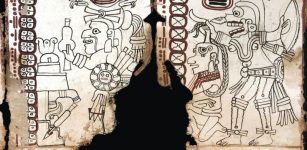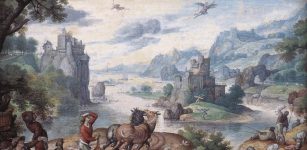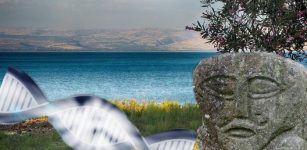Ancient Venetian Merchants Were Always Prepared For The Worst
Ellen Lloyd - AncientPages.com - Beautiful Venice in Italy is today recognized as one of the most charming cities in the world, and its ancient history is just as fascinating as this magnificent place's unique atmosphere.
J.M.W. Turner - Venice, The Dogana and San Giorgio Maggiore, 1834 - Credit: Public Domain
"In 1581, Francesco Sansovino, a Venetian who greatly admired his city, wrote that the name Venice derived from the Latin phrase Venietiam, which he said meant "come back again, and again, for however many times you come you will always see new and beautiful things." 1
This assumption concerning the origin of the name may not be accurate, but many still think Venice is like no other city in the world.
While strolling along the picturesque streets or enjoying the ride in a gondola, one can recall the daily life of 13th-century Venetian merchants who sometimes faced many dangers in the city.
A long time ago, Venice was merely a fishing village, but this small settlement eventually became one of Europe's most powerful states.
As John D. Irany writes in his book Venice in History, "the history of Venice is about simple things: the price of cloth, the design of ships, the transportation of spices and other goods. And it is about how such simple things affect the power and prosperity of nations. Like the Venetians themselves, we must approach their history from a worldview.
For hundreds of years, Venice was rich when the nations of the rest of Europe were poor. While London, Paris, and Rome were mired in the Dark Ages of Medievalism, the Republic of Venice–the Serene Republic–expanded in commerce, art, learning, and power. As such, Venice played a crucial role in the dynamic development of Europe.
In time, the changing fortunes of world events would allow other nations to challenge Venice's pre-eminent status successfully.
Bassanio, a theatrical character in Shakespeare's play "The Merchant of Venice" - Credit: Public Domain
But five hundred years ago, and for a thousand years before Columbus set sail to find a westward route to Asia, the Republic of Venice was the most exciting place. The citizens of the European nations that would later become great powers—England, France, Spain, and the Netherlands—could look only wistfully at the prosperity and wealth of the Venetians.
The Venetians readily expended their wealth on artistic and scientific achievement. Bellini, Tintoretto, Giorgione, and Titian were great masters of painting. The architects Andrea Palladio, Baldassare Longhena, and Jacopo Sansovino created churches, palaces, and even administrative offices of unsurpassed beauty. Galileo made his first astronomical discoveries while a professor at the Republic's university and later referred to his time in Venice as "the happiest years of his life."
With seemingly inexhaustible economic resources and unabated confidence in a bountiful future, Venetians built the glorious city that captivates all who see it, even today. In art, architecture, and scientific accomplishment, Venice in its time was the center of the world." 1
Though all this may give a glorying picture of Venice, one must remember life for the city's merchants during the 13th century was not always a luxury. During the 13th century, Italy was a collection of independent city-states, and to survive and prosper as a Venetian merchant, one had to have influential contacts or be friends with the most powerful families.
Using conflicts and wars to one's advantage could make a person tremendously rich. The Crusaders needed horses, soldiers, and ships. A cunning merchant would do all he could to offer transport and supplies at the highest possible price. This may sound a bit heartless, but a merchant's good life could change quickly because a failed harvest and the spread of diseases could end prosperity for a long time. Rivals and competition were a re-occurring problem in a place like Venice because this was "the city of choice for many merchants who utilized its European and Asian trade in the Holy Roman and Byzantine Empires." 2
Knowledge of the best trade routes was of utter importance if one wished to be successful, so merchants always wore a compass. Profitable goods, such as silk and spices, were highly desired products of Asia, but sweet Greek wine was also in high demand.
Even today, the first impression is often said last, and Venetian merchants take no risks when dealing with their clients. Wearing clean and fashionable clothes was a sign of confidence meant to reflect a trustworthy business person. Violence was naturally not uncommon, and carrying a dagger and a good sword was necessary. It happened when a merchant's ship or goods were stolen, and one had to defend property and sometimes life.
One can easily say Venetian merchants had to be prepared for the worst and always on their guard. Still, looking through our modern eyes, one cannot help wondering if this could have occasionally been forgotten in such a beautiful city as Venice.
Written by Ellen Lloyd – AncientPages.com
First version of this article was published on January 13, 2022
Copyright © AncientPages.com All rights reserved. This material may not be published, broadcast, rewritten or redistributed in whole or part without the express written permission of AncientPages.com
Expand for references- John D Irany - Venice in History: A History of the Serene Republic for Travelers
- Kevin McGivern – Trade, All About History, Issue 033
More From Ancient Pages
-
 Ancient Doll And Mythical Animal – 4,500-Year-Old Toys Discovered In Siberia
Archaeology | Dec 30, 2017
Ancient Doll And Mythical Animal – 4,500-Year-Old Toys Discovered In Siberia
Archaeology | Dec 30, 2017 -
 Why Didn’t Pythagoras And His Followers Eat Beans?
Ancient History Facts | Jan 18, 2019
Why Didn’t Pythagoras And His Followers Eat Beans?
Ancient History Facts | Jan 18, 2019 -
 Aegir – Jotun Lord Of The Stormy Seas Revered And Feared By Norsemen
Featured Stories | Sep 6, 2019
Aegir – Jotun Lord Of The Stormy Seas Revered And Feared By Norsemen
Featured Stories | Sep 6, 2019 -
 On This Day In History: Astronomer Johannes Kepler Observes Supernova – On Oct 17, 1604
News | Oct 17, 2016
On This Day In History: Astronomer Johannes Kepler Observes Supernova – On Oct 17, 1604
News | Oct 17, 2016 -
 Unexpected Historical Discovery: Remains Of Famous Sami Woman Recovered
Archaeology | Aug 22, 2022
Unexpected Historical Discovery: Remains Of Famous Sami Woman Recovered
Archaeology | Aug 22, 2022 -
 Did Richard The Lionheart Order Assassins To Kill Conrad Of Montferrat, King Of Jerusalem?
Featured Stories | Dec 27, 2018
Did Richard The Lionheart Order Assassins To Kill Conrad Of Montferrat, King Of Jerusalem?
Featured Stories | Dec 27, 2018 -
 Central European Early Iron Age ‘Hascherkeller’ Reveals Its Secrets
Archaeology | Jul 20, 2022
Central European Early Iron Age ‘Hascherkeller’ Reveals Its Secrets
Archaeology | Jul 20, 2022 -
 Once Looted Nearly 1,000-Year-Old Maya Text Is Authentic – Mexican Experts Say
Archaeology | Sep 1, 2018
Once Looted Nearly 1,000-Year-Old Maya Text Is Authentic – Mexican Experts Say
Archaeology | Sep 1, 2018 -
 Artificial Intelligence (AI) Unravels Secrets Of 22,000 Ancient Cuneiform Tablets
Artifacts | Feb 2, 2023
Artificial Intelligence (AI) Unravels Secrets Of 22,000 Ancient Cuneiform Tablets
Artifacts | Feb 2, 2023 -
 Why Was Ayllu Very Important For The Inca People?
Ancient History Facts | Feb 19, 2019
Why Was Ayllu Very Important For The Inca People?
Ancient History Facts | Feb 19, 2019 -
 Bacho Kiro Cave: Genomes Of The Earliest Europeans – Sequenced
Archaeology | Apr 8, 2021
Bacho Kiro Cave: Genomes Of The Earliest Europeans – Sequenced
Archaeology | Apr 8, 2021 -
 Spectacular Giant Bronze Age Hall Found Near Berlin, Germany May Be Connected To Legendary King Hinz
Archaeology | Nov 6, 2023
Spectacular Giant Bronze Age Hall Found Near Berlin, Germany May Be Connected To Legendary King Hinz
Archaeology | Nov 6, 2023 -
 The Ancient ‘Flying Machines’ Of Icarus and Daedalus
Featured Stories | Aug 16, 2014
The Ancient ‘Flying Machines’ Of Icarus and Daedalus
Featured Stories | Aug 16, 2014 -
 Ancient DNA Reveals Irish Are Not Celts – Irish Ancestors Came From Biblical Lands – Scientists Say
Archaeology | Mar 30, 2020
Ancient DNA Reveals Irish Are Not Celts – Irish Ancestors Came From Biblical Lands – Scientists Say
Archaeology | Mar 30, 2020 -
 Archaeologists Focus On Greek Poet Aratus’ Memorial Tomb And Ruins Of Soli Pompeiopolis
Archaeology | Aug 12, 2020
Archaeologists Focus On Greek Poet Aratus’ Memorial Tomb And Ruins Of Soli Pompeiopolis
Archaeology | Aug 12, 2020 -
 Secrets Of The Chephren Pyramid And Its Unknown Mysterious Force
Ancient Mysteries | Mar 20, 2015
Secrets Of The Chephren Pyramid And Its Unknown Mysterious Force
Ancient Mysteries | Mar 20, 2015 -
 Where Is The Grave Of Queen Boudica?
Ancient History Facts | Aug 15, 2017
Where Is The Grave Of Queen Boudica?
Ancient History Facts | Aug 15, 2017 -
 Sokar – Patron Deity Of Ancient Necropolis Of Memphis In Lower Egypt
Egyptian Mythology | Feb 19, 2019
Sokar – Patron Deity Of Ancient Necropolis Of Memphis In Lower Egypt
Egyptian Mythology | Feb 19, 2019 -
 Egyptian Gods’ Battle For Ancient Rome – Apis And Isis Cult Against Christianity
Ancient History Facts | Feb 9, 2018
Egyptian Gods’ Battle For Ancient Rome – Apis And Isis Cult Against Christianity
Ancient History Facts | Feb 9, 2018 -
 Controversial Hollow Earth Theory – Questions And Answers – Part 3
Ancient Mysteries | Jun 28, 2019
Controversial Hollow Earth Theory – Questions And Answers – Part 3
Ancient Mysteries | Jun 28, 2019


